Want to give up meat? Here’s how
Did your list of resolutions for 2021 include eating more fruits and vegetables and cutting down on meat? And were you by the end of January back to your old eating habits—the apples you bought during your weekly grocery trip slowly rotting in the fruit bowl and your freezer stuffed with packets of all kinds of processed meats? Worse, did you have a strong sense of déjà vu—you had done this before, last year and the year before that?
Supriya Bhattarai, clinical nutritionist and co-founder, Mitahara, says she has many clients who are striving to make the switch from a non-vegetarian lifestyle to a vegetarian one. She too has been trying to cut down on meat for the past six months. There are good days and there are bad days. It’s definitely not easy.
_20210327223141.jpg)
Supriya Bhattarai
But there are a lot of upsides to a vegetarian diet and therein lies its allure, says Bhattarai. A vegetarian diet, she adds, lowers the risk of many non-communicable diseases, like stomach ulcers and other gastrointestinal issues, as well as various cancers. Studies suggest a meatless diet could also help slow down aging.
“A plant-based diet is particularly good for those with heart problems. Removing meat from your diet is great for overall wellness,” she says.
Bhupal Baniya, nutritionist at Nepal Police Hospital, too recommends a vegetarian diet. He says if you can, you should definitely give up meat because its consumption comes with a fair share of long-term health issues.
The problem with meat today is that a lot of poultry and animals are bred and raised to be slaughtered. Animal cruelty aside, they are given hormones and antibiotics which we ultimately end up consuming.
“There are many antibiotics that were earlier used to treat diseases in humans, like tetracycline, that we are now resistant to. That’s because we consumed drug-fed poultry,” says Baniya. A meat-rich diet could potentially lead to kidney, liver, and heart problems, he adds.
_20210327223140.jpeg) Bhupal Baniya
Bhupal Baniya
“It’s not just meat, how we consume it is also problematic,” he says. Most of the times, we grill or deep fry meat (think sizzling barbeque or chicken lollipops). This coats your food with carcinogens.
Take it slow
Dr Ruby Bajracharya, dietician, ayurvedic doctor, and founder of Lotus Ayurdeva, supports Baniya’s claims. She says a non-vegetarian meal is acidic in nature and an acidic diet is what causes health problems, including cancers. On the other hand, a vegetarian diet, if you keep it as colorful as possible, could help prevent many illnesses.
“Try to include different kinds of vegetables in your diet. If possible, eat different things for lunch and dinner every day of the week,” says Dr Bajracharya. It would also be a good idea to have foods in their closest natural states, which is possible with fruits and vegetables.
According to the ayurvedic doctor, a simple home-cooked meal can be your key to wellness. If that doesn’t include meat, all the better. But she stresses on the need to be practical about your eating habits. If you have been eating meat, say daily, for as long as you can remember then you probably wouldn’t be able to give up cold-turkey. And neither should you.
_20210327223141.jpg) Dr Ruby Bajracharya
Dr Ruby Bajracharya
“What you can do is reduce the frequency or the portion size and then slowly try to eliminate it from your diet. This is a far more sustainable way to give up meat in the long run,” she says.
Nutritionist Bhattarai agrees that if you want to give up meat it’s important not to rush it. The mantra here is to cut back and work on making meat less tempting. For instance, you could opt for pan-grilled meat instead of the fried version which is more addictive, making it harder for you to give it up altogether. You will, over time, find meat less palatable when you come to associate it with bland dishes.
The body, she adds, takes time to adapt to new foods and flavors. By lessening the quantity of meat and increasing the portion of vegetables, you will slowly develop a taste for vegetarian food as well.
“Start by paying attention to how you are eating meat and try to change that. You could also try abstaining from one item, like mutton, to start with,” she says. It’s what she has done: she has first given up red meat.
Find your why
Experts agree that it helps if you are clear about why you want to cut out meat from your diet. Is it because you love animals and want your meals to be cruelty-free? Is it because you are concerned about the meat industry’s impact on the environment? Or do you think a vegetarian/vegan diet is healthier and want to feel good in your body?
When you have a solid reason for doing something—especially something that requires a lot of discipline and behavioral changes—you are more likely to see it through.
Founder of Vegan Diary Nepal Kajol Sethia says she turned vegan because she loves animals. A plant-based diet has made a lot of difference in how she feels. Besides losing weight, a diet rich in fiber, vitamins and minerals has made her more energetic. Bloating, something she struggled with earlier, isn’t an issue anymore. She claims she is fit enough to run a 5k or 10k marathon and still not feel drained out. For that, she credits her food choices.
_20210327223140.jpg) Kajol Sethia
Kajol Sethia
“Many people think being vegetarian or vegan is difficult as it limits your food options. But, in fact, it’s about removing certain things from your plate and replacing them with something else,” says Sethia.
For instance, if you are a non-vegetarian transitioning into vegetarianism, you could simply remove meat from your plate and replace it with eggs, cottage cheese, or mushroom. Similarly, if you are trying to go vegan then use oil in place of ghee and have tofu instead of cottage cheese.
The passionate vegan believes it has never been easier to find alternatives—with the concept of mock meats (a meat-like substance made from plants) and many online businesses delivering any fresh produce you could want at your doorsteps. Also, a dish is tasty because of the spices we use to temper it. Anything can be made mouth-wateringly delicious with the right technique.
Arm yourself with information
However, Sethia confesses that earlier she was ignorant about her food habits and consumed a lot of junk food. That took a toll on her health. Since 2015 she has made it a point to educate herself about food and nutrition, which has helped a lot. It is what she advises everyone to do before embarking on a new diet.
“You have to be aware of what you are putting in your body and how that can affect you. So, do your research to figure out what works for you,” she says.
But Google can be a rabbit hole, with a lot of myths and false claims. Where your health is concerned, you can’t afford to take chances. Consulting an expert at the start of your vegetarian or vegan journey might be a good way to go about it. A dietician or nutritionist will give you specific information and tailor a plan for you.
“You run the risk of nutritional deficiencies when you go plant-based or if you have been a vegetarian for a long time,” says nutritionist Baniya. You have to be especially careful about monitoring your vitamin B12 levels, ensure you are getting the needed essential amino acids, and meet your protein requirements through adequate intake of lentils and grams.
Making sustainable changes
Experts’ unanimous opinion is that these are minor hiccups that can be easily addressed. These days supplements are easily available to meet your nutritional requirements. A handful of nuts and seeds daily—like walnuts, chia seeds, flax seeds, to name a few—can be a good source of healthy fats that might be lacking in a vegetarian diet.
For a transition into vegetarian or vegan lifestyle to work, the best thing you can do is make small, sustainable changes that can become habits over time. Dr Bajracharya suggests making a change and diligently sticking to it for 21 days (three weeks) to build a habit and then for 49 days (seven weeks) to make it a part of your lifestyle.
Bhattarai suggests being a little more mindful about food and letting your body adapt to new flavors and ways of eating. For Baniya, a slow and steady approach is the best way. If you consume 10 kilos of meat a month, try having only five kilos for the next few months and then further reduce that, to eventually get to zero when you feel you are ready.
Sethia swears by cultivating a healthy relationship with your body and food. Food, she says, should make you feel good and be light on your body and conscience.
“If you want to follow a more plant-based diet but haven’t been able to do so, you haven’t found the right reason and approach yet. Work on them. And find innovative ways to include more greens in your diet,” she concludes.
The slippery slope of self-medication
Pop a painkiller and get to work—That’s the busy millennial life. An annual medical check-up or that ultrasound to figure out just what’s causing the recurrent what-feels-like heartburn can wait. Meetings, presentations, and paperwork at the office take precedence over our health because, really, who doesn’t have niggling pains and aches every once in a while?
It’s this mindset that has most people self-medicating themselves. Pharmacists around the valley confessed that on a daily basis they have more people coming to buy medicines without a doctor’s prescription than with one. And they aren’t just buying paracetamol or anti-diarrheal pills. More often than not, it’s antibiotics, blood pressure medications, and even psychiatric drugs.
Pharmacist Krishna Dhakal, who has been running Narayani Pharmacy in Thapathali, Kathmandu, for 22 years, says it’s the easy accessibility to drugs that has people becoming their own doctors. A quick Google search of your symptoms and a trip to the nearest pharmacy is most people’s two-step treatment plan.
“This approach is sure to backfire sooner or later. You are doing your health a great disservice if stopping by a pharmacy and buying random medicines is a regular thing,” says Dhakal, adding many people also tend to look at their friends’ cases as reference for self-diagnosis. If so and so medicine cured a friend’s sore throat then it will surely work for them too, they think.
“But each case is unique or there might be an underlying cause of your problem that could get worse without the right treatment,” he says.
According to Nim Raj Tamang, assistant pharmacist at Nirvan Pharmacy in Pulchowk, Lalitpur, earlier it was mostly people from low-income groups who used to visit pharmacies with their health woes. They were trying to save on doctor’s consultation fees. That money, they felt, could be used to buy a month’s supply of medicines. But as the internet became more pervasive, everyone slowly became experts in treating themselves.
Zero faith in healthcare
During the Covid-19 pandemic, Tamang says, many people hoarded antibiotics and took them for a day or two at the slightest hint of a runny nose or cough. This happened and continues to happen because of two reasons, he believes: First, people aren’t aware of antibiotics resistance and what overusing them can lead to and second, most people have a couldn’t-care-less approach to health as long as they aren’t ill or in pain as there is always more important work to be done.
But self-medication isn’t a trend only because it’s convenient. Talking to random people out and about their day—catching up with friends at a coffee shop in Battisputali, shopping at a grocery store in Sanepa, and having masala tea at Pulchowk in the evening—ApEx found that majority of people seem to have no faith in the country’s healthcare system, which is curative rather than preventive.
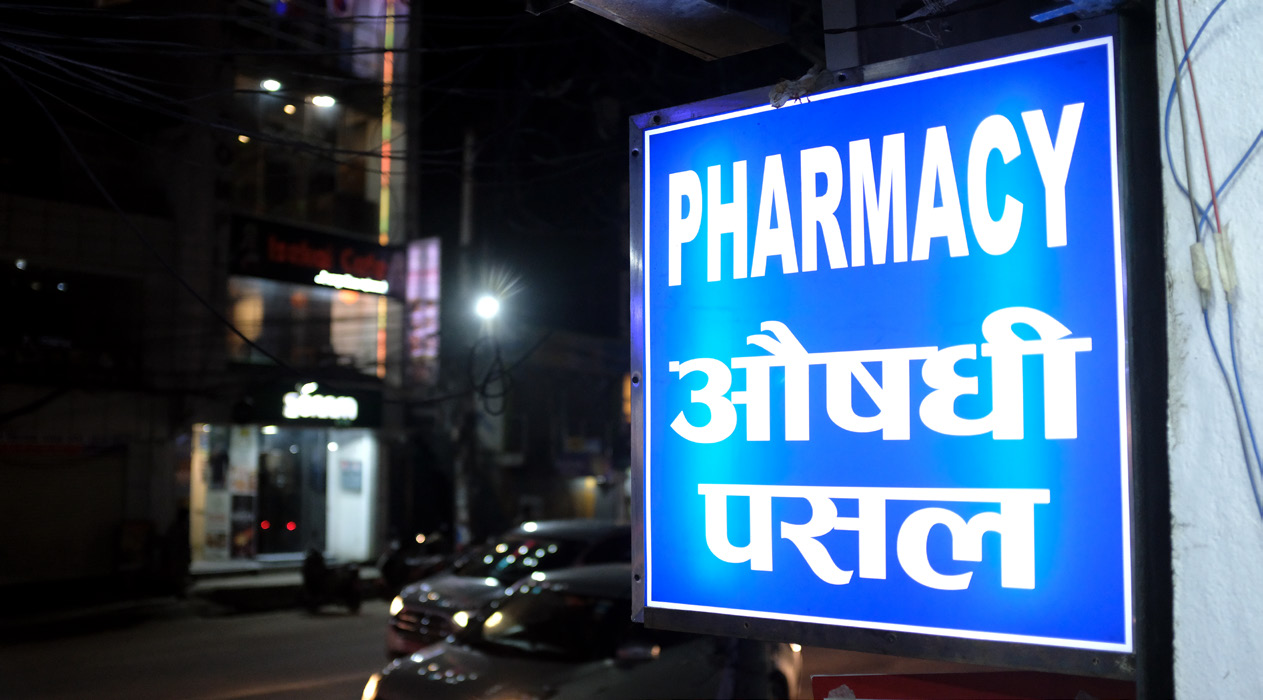
Doctors, they said, don’t give you more than two minutes or listen to your queries properly unless your condition is serious. The unanimous opinion was that there was no point in annual health checkups or consulting doctors unless you thought there was something seriously wrong with you.
Sarah Shrestha, 32, a public relations officer, says her company pays for an annual full checkup but she, in the past two years, hasn’t been to a hospital. Shrestha says she doesn’t want to spend an entire day at a hospital getting tests after tests done and then another day waiting for the doctor to look at her reports and certify she’s in good health and prescribe vitamins.
“I would know if I was sick, wouldn’t I? So, if doctors aren’t going to tell me how I can stay healthy or counsel me about what I should or shouldn’t do in the future, then I will only schedule an appointment when I’m actually unwell,” she says.
Roshan K.C, 24, who is taking a gap year before going to India for his masters later this year, says a pharmacy visit will suffice for minor ailments because there is nothing a pharmacist won’t tell you that a doctor will.
“Of course, doctors have more knowledge but in Nepal they don’t have the time or the willingness to share that information,” he says.
It seems Nepalis are definitely more inclined than ever to rely on over-the-counter drugs unless they perceive themselves to be in life-threatening situations. Of the 25 people questioned, 24 said hospitals in Nepal were only for emergencies and surgical procedures.
Lasting damages
However, the impact of self-medication is far-reaching. Immediate serious side-effects aside, misuse of drugs can give rise to long-term health problems that are difficult to cure because your body doesn’t respond to treatments. Improper dosage of antibiotics or failure to complete its course could lead to your body becoming resistant to it. You will thus require stronger medicines in the future. Its overuse, on the other hand, could destroy your body’s natural flora making you prone to various infections and diseases.
“Little knowledge is a dangerous thing. As clichéd as that might be, it couldn’t be truer,” says Suman Dawadi, a pharmacist at Sesaang Pharmacy in Thapathali, Kathmandu. He says a lot of times people come to the pharmacy asking for a tablet or two of antibiotics.
“I think in such cases the onus lies on the pharmacists too. We should not sell the medicines, or we should make people aware about the proper dosage and the importance of sticking to the recommended course even when their symptoms go away,” says Dawadi.
The problem is, he says, that is not what happens and one or two pharmacies developing a conscience isn’t going to change much. There isn’t a strict drug regulation and monitoring system in Nepal. Most medicines that shouldn’t be sold over the counter are being bought recklessly without prescriptions.
The Department of Drug Administration under the Ministry of Health and Population has classified drugs into different categories—a, b, and c—with statutory warnings printed in bold red on packages of drugs that shouldn’t be sold without a prescription.
Category ‘a’ consists of narcotic and poisonous drugs. Antibiotics, hormones etc. fall under category ‘b’. These are prescription drugs and can only be sold by a pharmacist or a medical professional. The drugs that fall under category ‘c’ are the only ones that can be sold over the counter, without a prescription.
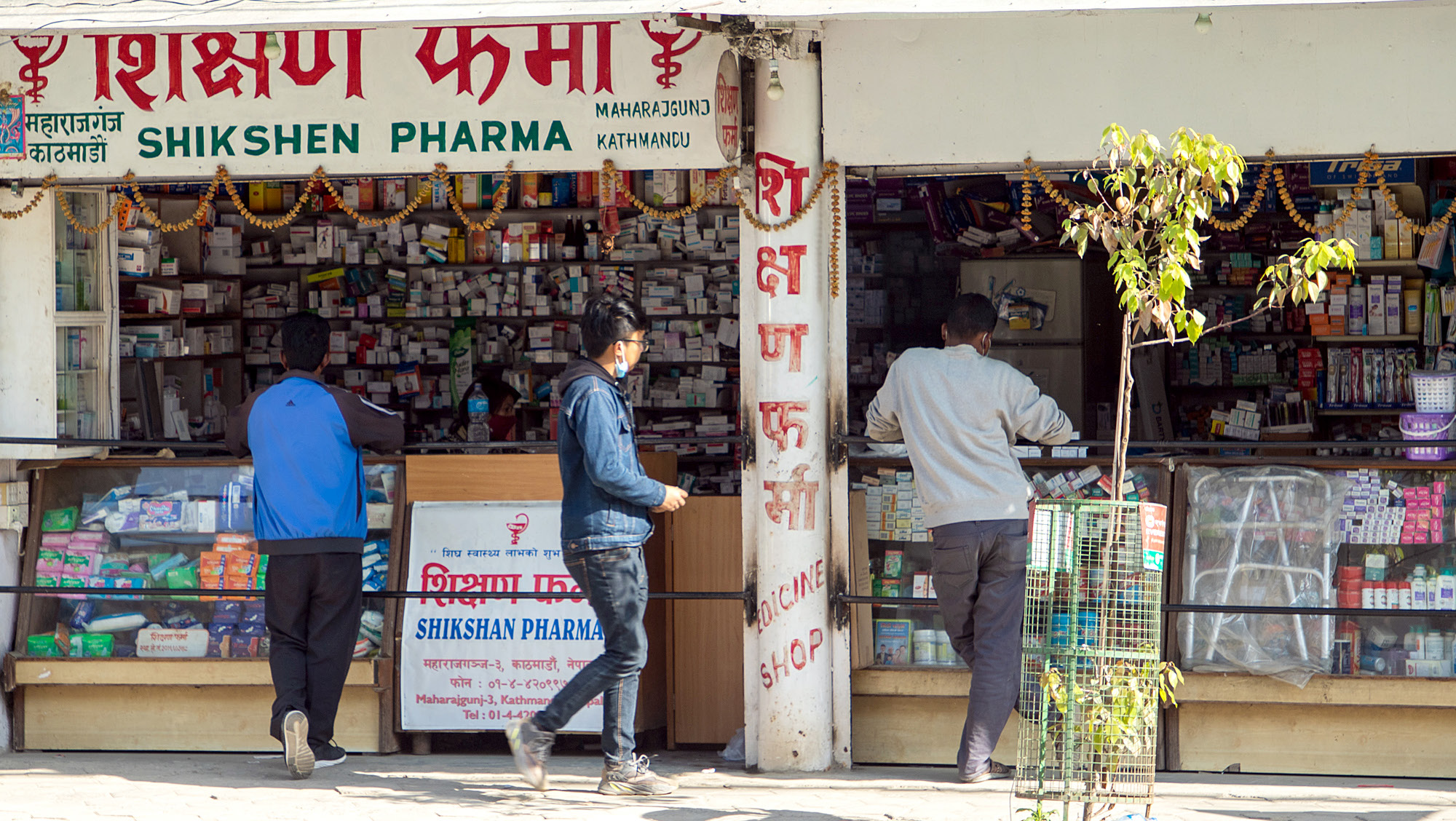
“Unfortunately, in Nepal, everything is being sold over the counter,” says Dhakal. He says it’s not unusual for people to come with old prescriptions for fresh complaints, claiming the medicine worked in the past and so they will just continue with it. Topping up prescription drugs without going for a follow-up is also quite common. What the doctor intended for you to have for six months, say for high blood pressure, you’ve probably had for a year or more.
“With stricter rules to ensure prescription drugs couldn’t be sold over the counter, people would have to go to see a doctor when they are unwell,” says Sanjit Chaudhary, pharmacist at Alka Hospital Pharmacy in Jawalakhel, Lalitpur.
That alone, however, won’t be effective in curbing the problem, argues his colleague, pharmacist Sajan Chaulagain. The issue here, he points out, is that there are just too many community pharmacies that are often run by people with zero pharmaceutical knowledge. As pharmacies have become business- and not service-oriented, even if a certain pharmacy does not sell prescription drugs without a doctor’s slip, there are bound to be at least ten others that will.
“People need to be cautious where their health is concerned. It’s not something to be taken lightly. We can’t always depend on rules, laws, penalties or on the government,” says Chaulagain.
The way out
Dr Namita Sindan, gynecologist at Paropakar Maternity and Womens’ Hospital in Thapathali, Kathmandu, agrees and says she is appalled by people’s ignorance and carelessness in health matters.
Stringent drug regulation laws wouldn’t hurt but a lot more needs to be done to tackle the problem, says Dr Sindan. There needs to be greater awareness about the long-term repercussions of being negligent with your health. Medical professionals—doctors, nurses, pharmacists—must also strongly dissuade people from self-medicating.
“There was recently a maternal death because the woman had taken random painkillers to manage discomfort. Her child died in the womb and that led to a fatal infection,” she says adding there are also many preventable deaths in the country because women take abortifacient drugs to terminate unwanted pregnancies without medical advice.
There are many contraindications for drug use, especially in case of antibiotics and other prescription medicines. A medical personnel can determine which drug will work in which case and when a certain medicine shouldn’t be administered. This knowledge comes from training and practice. An internet search or even pharmacists can’t give this information to you.
A general consensus among medical experts seemed to be that people could explore telemedicine that enable them to get health-related services and information through video-conferencing apps and tools. Something is better than nothing is the principle that could be applied here, says Dawadi, adding when even simple over-the-counter medications can have rare but severe adverse reactions, it’s best to err on the side of caution.
“There is no substitute for expert advice. A consultation or checkup instead of popping random medicines could save you from many unnecessary health troubles, if not potentially save your life,” concludes Dr Sindan.
Should Nepal’s elderly take the Covid-19 vaccine? Absolutely, say experts
The Ministry of Health and Population is all set to begin the second phase of immunization against Covid-19 from 7 March 2021. Those above 55 are the priority this time. But most people belonging to this group seem hesitant. They aren’t sure if the vaccine is safe.
This concern stems largely from what they have seen on social media. Many people who got the vaccine, worldwide, have complained of headaches, fever, and fatigue among other side-effects. Also, the fact that the first phase of the vaccination in Nepal saw a moderate turnout, with only half of the prioritized individuals inoculating themselves, has people questioning its safety, efficacy and need.
Tara Shrestha, 66, housewife and resident of Pulchowk, Lalitpur, says her eldest daughter who’s in London, UK, suffered from fatigue and fever after getting the vaccine. Shrestha wasn’t enthused about getting vaccinated in the first place and now she has made up her mind: She isn’t going to.
“There’s no point of it if it’s going to make me ill. At least I’m okay right now and there’s no imminent danger,” she says.
Safety concerns
The effects of the pandemic-induced infodemic—wherein everybody became an expert and made their ideas public via social media leading to information inundation—has perhaps never been as evident as today, fueling a sense of unease and skepticism. People don’t know what to believe in but the worst of it doesn’t leave their minds.
‘What if the vaccine doesn’t work and makes me sick with Covid-19 instead?’, ‘What if I am allergic to the vaccine?’, ‘Will I have to keep getting new shots every time the virus mutates?’ and, ‘Do we actually need a vaccine as Covid-19 infections are already on the decline?’—These were some of the common concerns among a random sample of 37 people ApEx spoke to on the streets of Lalitpur and Kathmandu.
Saraswati Karki, 47, who runs a grocery store in Gaushala, Kathmandu, isn’t going to let her parents and in-laws, all of whom are over 60, get inoculated. She sees no need for it as she believes the threat has largely passed. She says home remedies like turmeric water and ginger fenugreek paste have protected her family so far. They will continue consuming different herbal concoctions like these to stay safe.
“I wouldn’t have been so opposed to my family getting vaccinated if I was sure it was safe. Everybody I know who has gotten the vaccine has complained of one or the other side-effect,” she says.
Queries answered
However, Sameer Mani Dixit, PhD, a public health expert, says everyone, except those who are severely immunocompromised, should get the vaccine.
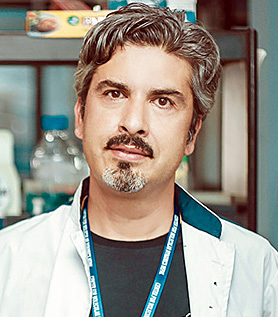
No one should be in two minds about it, he says. The Covid-19 vaccine is not at all harmful and poses no threats whatsoever to the human body. What’s important to understand, he says, is that every vaccine will have some side effects and that’s completely normal.
“The idea that you can get Covid-19 from the vaccine is baseless,” says Dixit. What’s true instead, he adds, is that millions of elderly people around the world have been vaccinated against Covid-19 and no one has died or even been gravely ill.
“As far as I know, even fever isn’t a common side effect of the vaccine among the elderly,” he says. This, he explains, is because as you age your immune response becomes low and doesn’t kick in as effectively as it would have when you were younger.
Various reports suggest that mild body ache, chills, and other flu-like symptoms are common and go away in a couple of days. The side effects are a small price to pay for the potential risks you run if you choose not to get jabbed.
Dr Shailendra Kushwaha, consultant cardiologist at Norvic International Hospital, Thapathali, Kathmandu, says the WHO guidelines for the Covid-19 vaccine clearly state that everyone except those under 18 and those suffering from acute phase of fever, cough or other diseases requiring hospitalization are eligible for the vaccine.

Vaccine contraindications
Dr Kushwaha says there are a lot of false beliefs emanating from lack of information dissemination and the resultant unawareness.
And indeed, unavailability of information regarding the vaccine—its importance and contraindications—was cited as a major reason most people didn’t want to get vaccinated. Even those who thought they would eventually have to get it wanted to wait and watch for a while, see how others would react to it.
According to Dr Kushwaha, the vaccine is contraindicated for those who have previously had allergic reactions to vaccines or injectable therapies and other pharmaceutical products. It’s also not recommended for pregnant women and lactating mothers as these groups haven’t been part of any Covid-19 clinical trials so far.
The vaccine is also temporarily not advised for those who have active symptoms of SARS-CoV-2 infection or those who have been given anti-SARS-CoV-2 monoclonal antibodies or convalescent plasma as well as those who are currently unwell and hospitalized.
“For those who have a history of bleeding or coagulation disorder, it’s best they get the vaccine under their physician’s supervision,” says Dr Kushwaha, adding that this is currently what we know for sure about the vaccine based on clinical trials.
“It’s all very new and much of it is being studied. We still don’t know many things about the vaccine and new information will become available as we move forward. But that doesn’t mean we have to be scared of getting vaccinated,” he says.
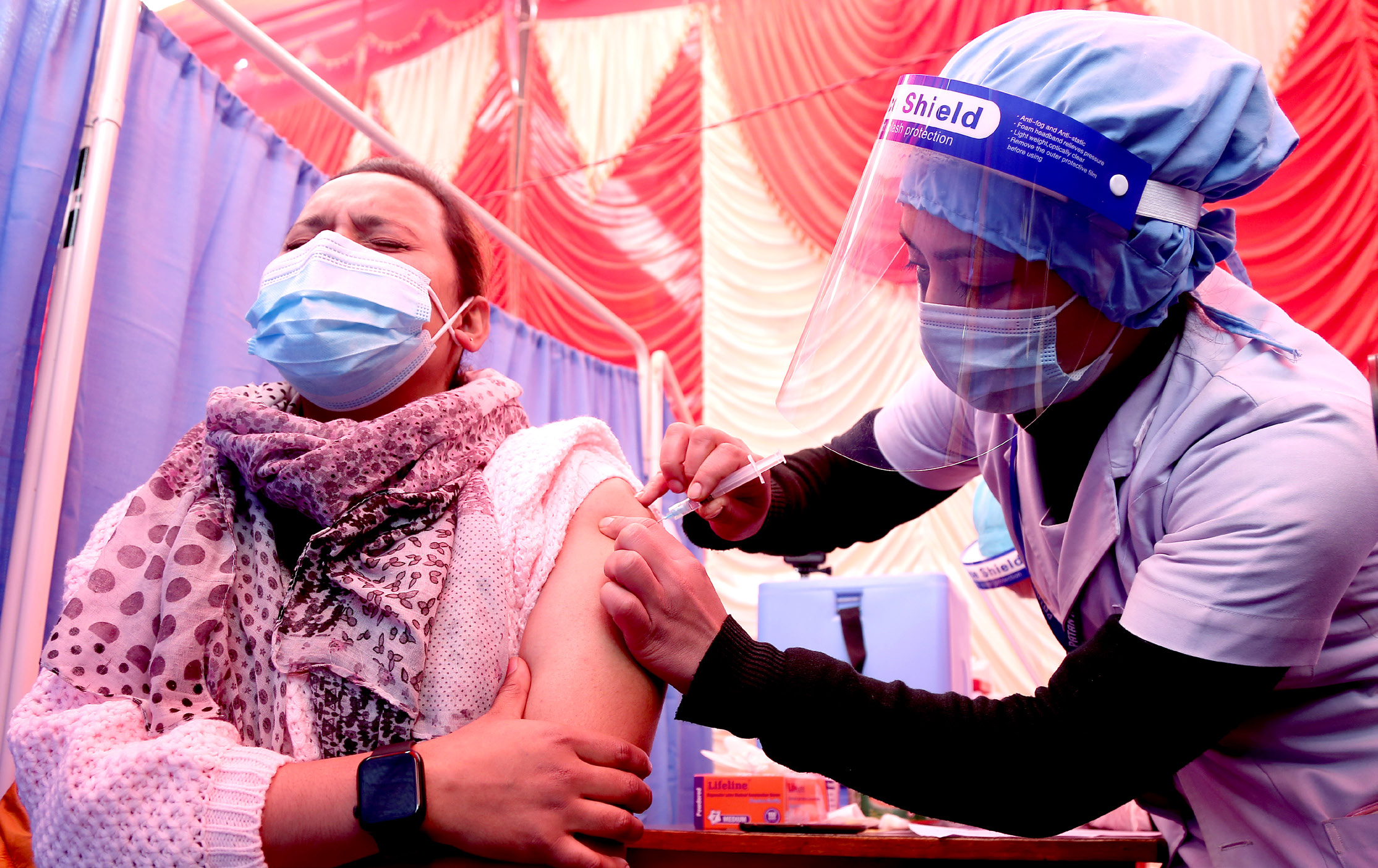
Both the experts—Dixit and Dr Kushwaha—also stress on the importance of the vaccine for those who have already contracted Covid-19. Dixit says if you have recovered from Covid-19, there’s no reason why you shouldn’t get vaccinated to give your immune system the boost it needs to fight future infections.
Informed decisions
What’s unfortunate is that the Nepal government hasn’t been able to effectively convey just how vital it is that everybody takes the vaccine. Out of the 37 people we talked to, 34 confessed they thought the vaccine was unsafe. They felt the government must have procured low-quality vaccines or made some compromises for commissions.
Sunny Vaidya, 26, who works at Dhukuti, a retail outlet for the Association of Craft Producers, in Kupondole, Lalitpur, says it’s the general sense of mistrust that leads to fear—more so now when our health is at stake.
“Our government is a sham. Everything it does benefits the ones in power and puts the rest at a disadvantage. It’s hard to believe they have the public’s interest in mind while urging us to get vaccinated,” he says.
Vaccines work by mimicking an infectious agent—viruses, bacteria or other microorganisms—that can cause a disease. It trains and prepares our immune system to effectively and quickly respond against it, thus preventing its multiplication that leads to diseases. Getting the Covid-19 vaccine readies your body to fight the virus should you get infected.
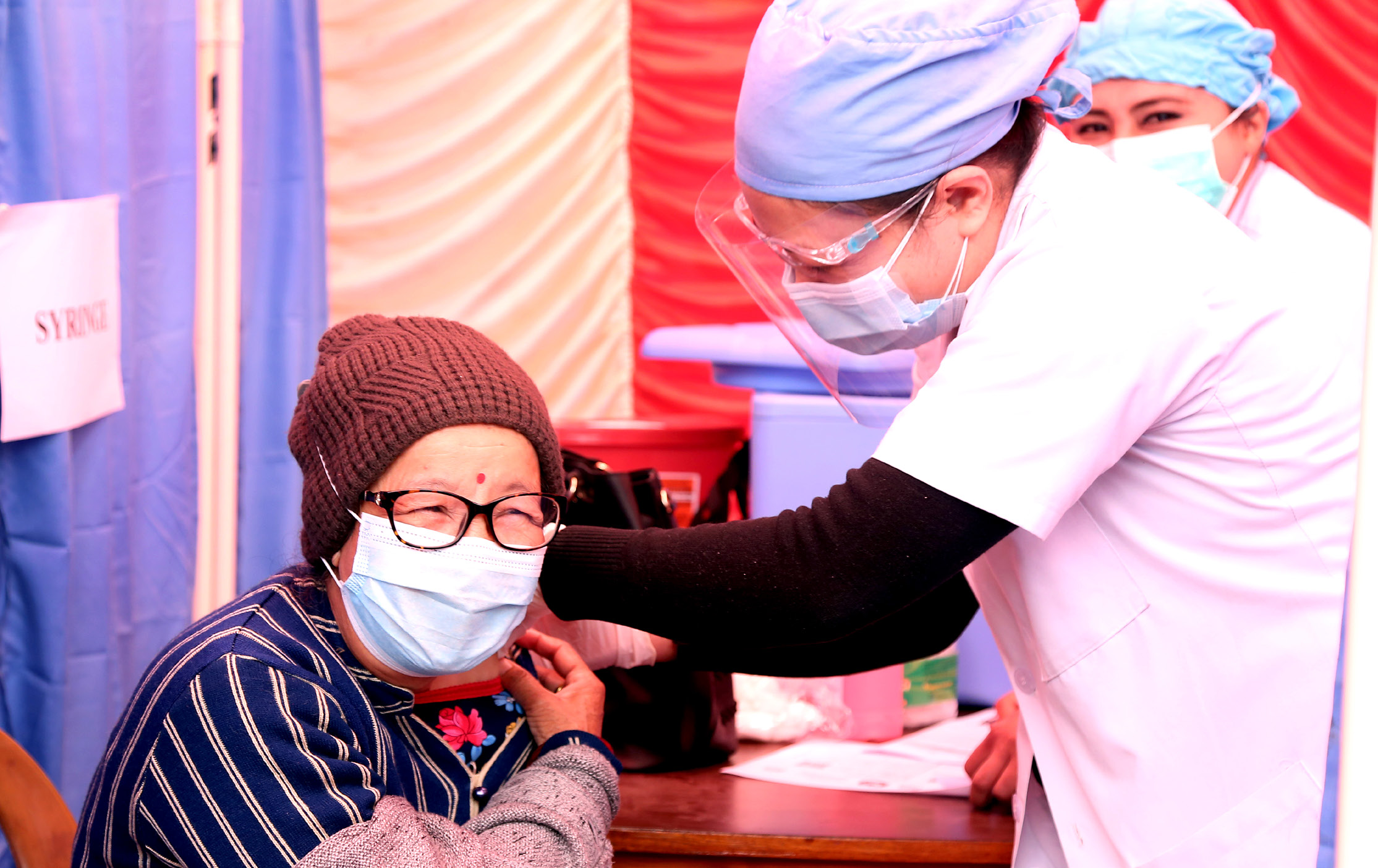
According to Dixit, many people also seem to think that being vaccinated means they will not be infected by the virus, which is not true. What happens is that their bodies will fight the virus and not let it multiply, thus effectively killing it, because their bodies have been prepped to recognize it as a threat.
“You might get infected with the virus after you take the vaccine but you won’t suffer from the diseases it could cause,” says Dixit. And given all the potential complications of the novel coronavirus, getting the shot seems to be the safest bet.
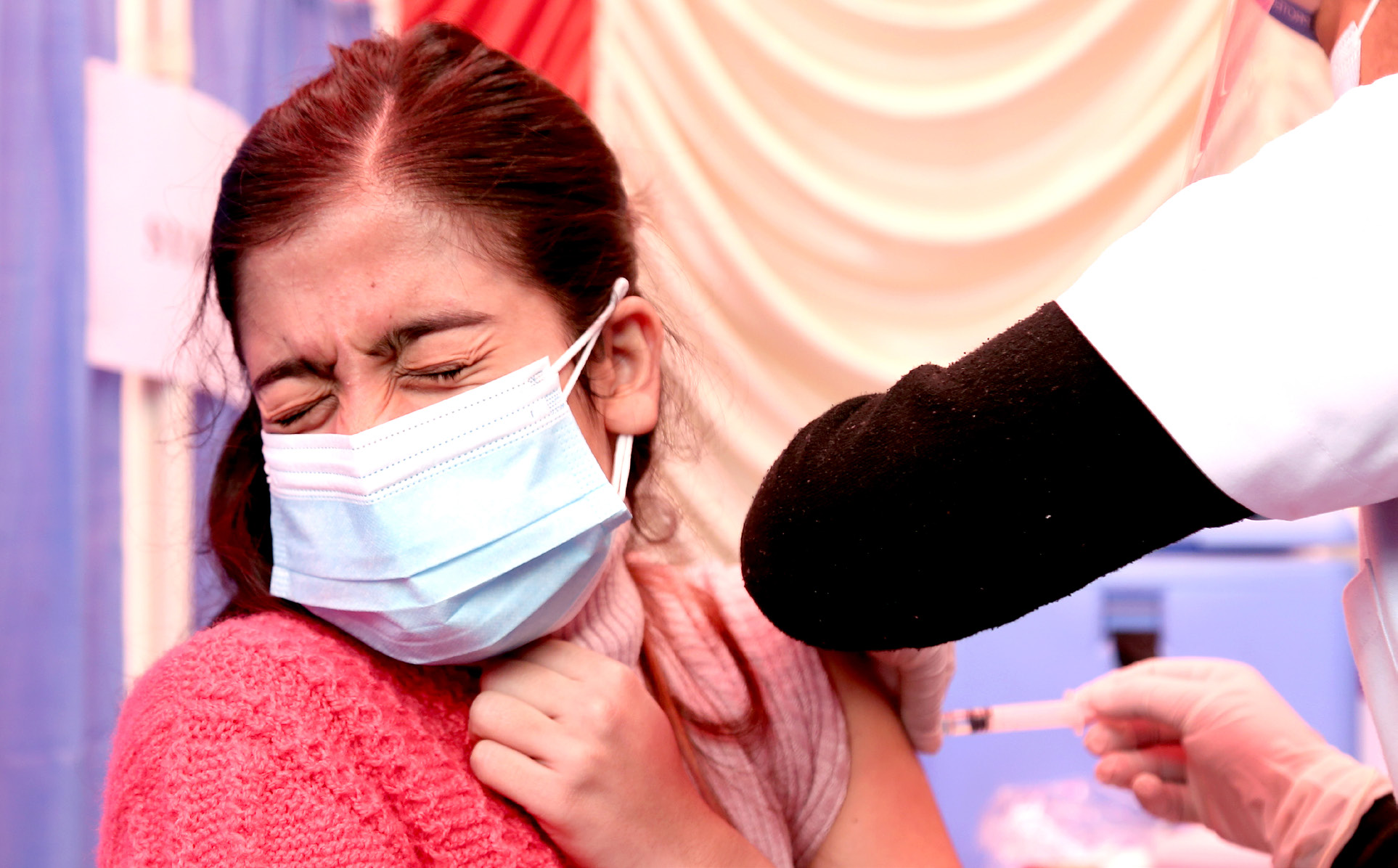
Acts of charity: When a little goes a long way
While most of us were busy whipping up dalgona coffee and baking banana bread during Covid-19 lockdowns, Ayushma Rana was out distributing food packets to those in need. Despite her family’s repeated pleas to stay home as she had two small children and aging parents, Rana could often be found scurrying from one place to another in Bhaisepati, Lalitpur, trying to reach as many daily wage workers as possible.
“I told my family I would help 100 people and then I would stay at home. When that goal was met, I said 50 more, and I’d stop. But before I knew it, I’d managed to reach 6,000 people,” says Rana, founder of ST Group which deals in luxury gift packaging and event management.
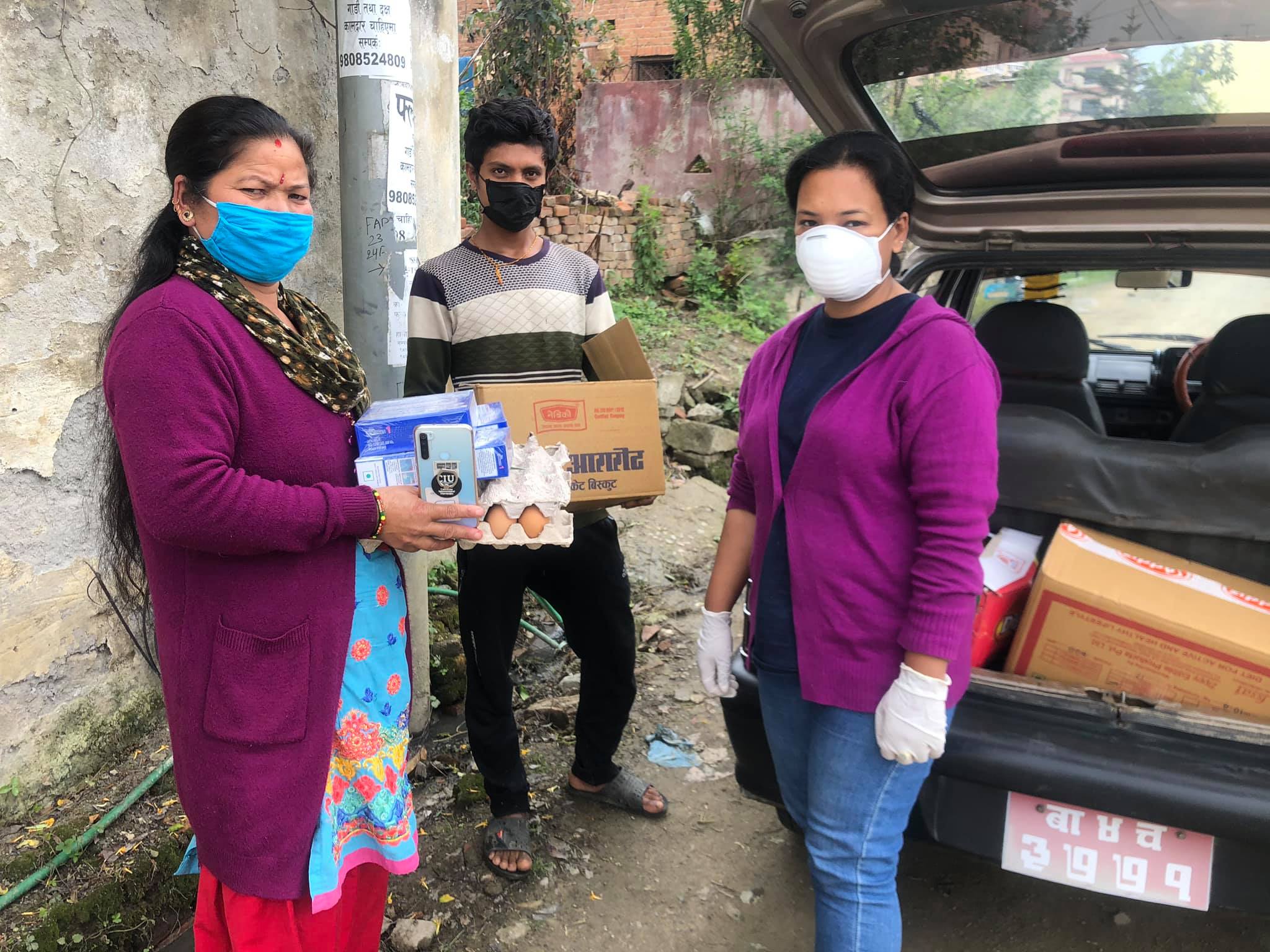 Ayushma Rana distributing food packages during Covid 19 lockdown.
Ayushma Rana distributing food packages during Covid 19 lockdown.
This, however, wasn’t anything new for her. Rana has always tried to do whatever little she could whenever she could. During the 2015 earthquakes, her home in Ekantakuna, Lalitpur, got destroyed but she and her brother were out helping victims with food, medicines, and other necessities. Since 2016, she has also been distributing socks and woolen caps to street children, vendors, milkmen, and garbage collectors every winter.
“I believe each one of us must do what we can whenever we can. Every little bit counts especially in a country like Nepal where the government is apathetic and so many people struggle to make ends meet on a daily basis,” she says.
Her views are echoed by Saurav Rimal, who is involved in various smart city projects. Rimal says we have, for far too long, been complacent and thus dependent on the local authorities and the government. We are quick to complain but hesitate to take action, he adds.
When Kathmandu was under a lockdown, Rimal visited places in the city like Gongabu bus park, Bhrikutimandap, and Kirtipur that used to be crowded pre-Covid. His goal was to find daily wage earners who were struggling to put food on the table.
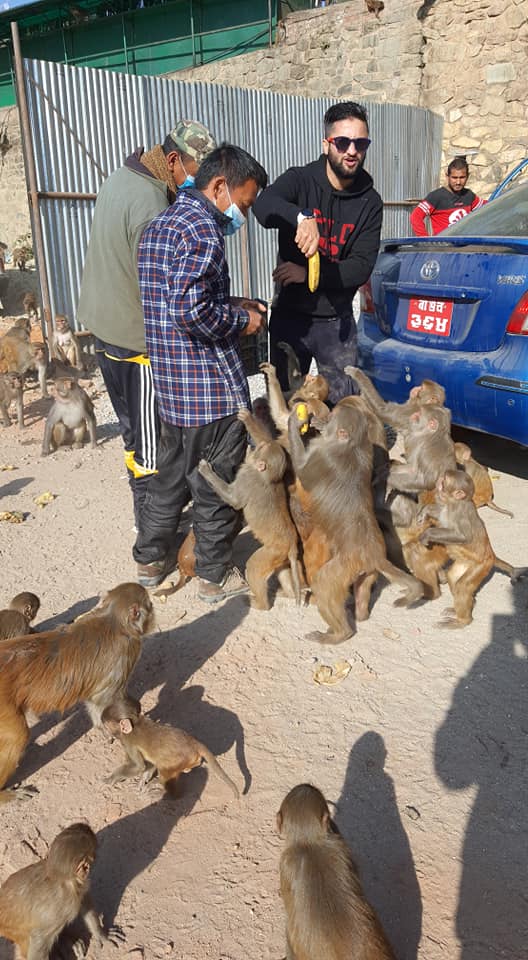
Saurav Rimal feeding monkeys during the Covid-19 lockdown.
Rimal’s efforts kept more than 500 families from starving during the lockdown. He also fed monkeys and stray dogs in and around the Pashupati and Swayambhunath areas.
Recently, Rimal distributed jackets and blankets to sugarcane farmers from Sarlahi who were in Kathmandu for a protest. They were asking the government to see to it that the sugar mills cleared their dues.
Many of them, he says, didn’t have a proper place to stay and had flimsy clothes ill-suited for Kathmandu’s steadily dipping temperature. Rimal used his own savings and money sent by friends abroad to buy them some warm clothes as well as make arrangements for a decent place to stay.
“I know what I’m doing isn’t sustainable. There is only so much I will be able to do with my limited resources. But I still intend to do everything I can for as long as I can,” says Rimal.
This is where unity as Nepalis would come in handy, he adds. If communities came together to help those in need instead of merely cribbing about how the government doesn’t do anything, we could witness a sweeping change across the nation.
“Unfortunately, most people have the mindset that as long as they are paying their taxes, they needn’t be bothered with anything else,” he says.
No help is small
Juju Kaji Maharjan, who comes from a family of social workers, feels this is because most people underestimate the power of a single person working for a cause. They don’t think feeding a homeless person or helping a family with their hospital bills can make much of a difference.
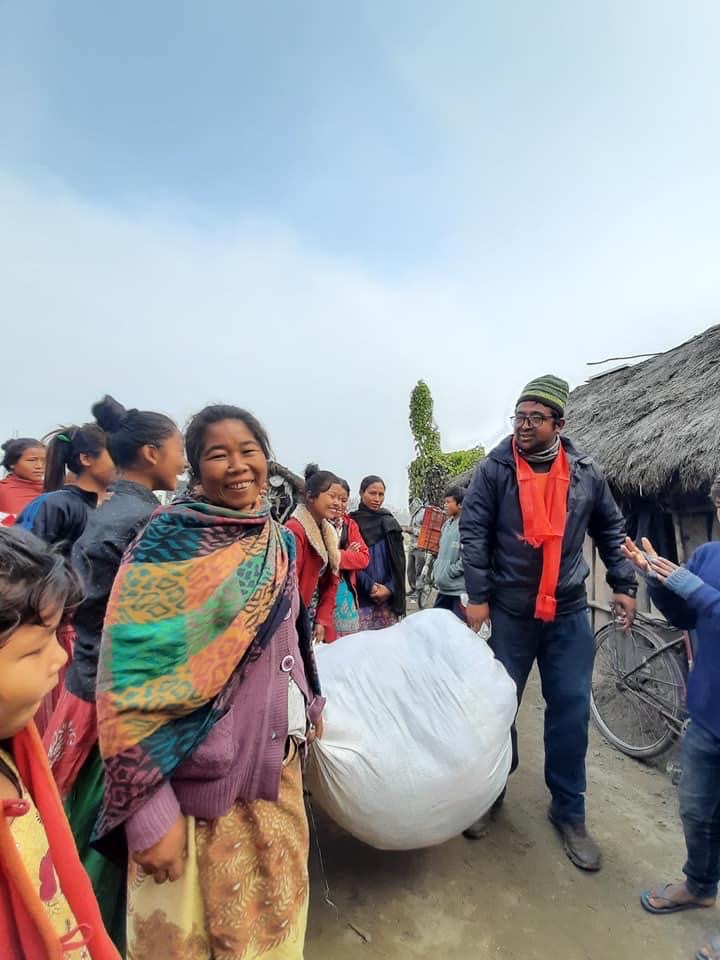
What most don’t understand, he says, is that small actions can have a ripple effect and ultimately lead to big changes. The results of those small actions aren’t immediately visible that a lot of people find it difficult to stay motivated.
Rana says helping others gives her a sense of peace and more people should do it because it feels so good. “It’s an endorphins rush that you’ve got to experience,” she says. When she hands someone a pair of socks, she is consoled by the fact that the receiver might stay a little warm, at least for that night. Every selfless action has the potential to make life a little better for someone else and for you too, she adds.
According to Dristi Thapa, who works at The Orphan’s Home in Nakku, Lalitpur, no help is big or small. What matters is you choose to operate out of a place of love and that will never go unappreciated.
Thapa started working at the orphanage as she has always believed in the importance of giving back and making a difference, as small as that might be. The children at the home, she says, take delight in the tiniest of things. For example, they were ecstatic about a slice of cake they all got on her birthday. Their eyes just lit up, she says. You would have to consider yourself lucky to be a harbinger of that kind of pure happiness.
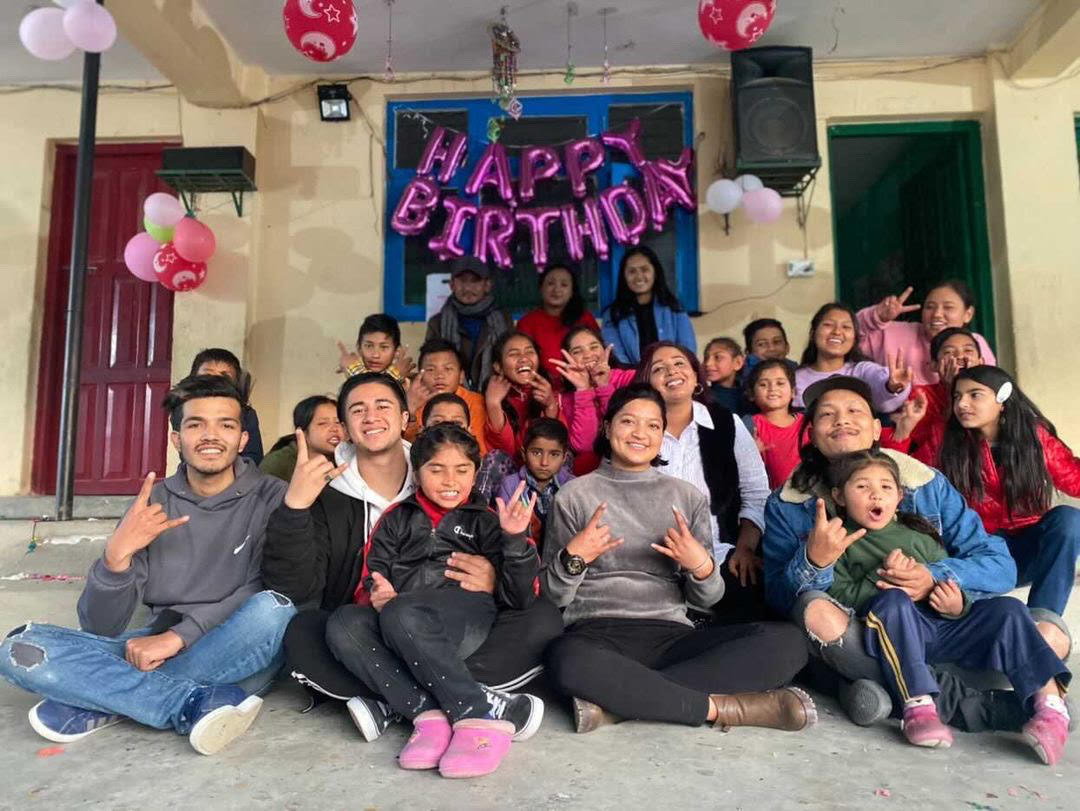 Dristi Thapa celebrating her birthday with orphans.
Dristi Thapa celebrating her birthday with orphans.
“I might not be able to do very much but if I can bring even the littlest of joys in a child’s life then it will be a life well lived,” she says.
Joy in feeding
Jimi Prem Karthak, proprietor of The Lunch Box, a fast-food restaurant in Kupondole, Lalitpur, runs Food for Naanis program. It was initiated with a simple idea of providing good food for children who need it. The program runs in the city and, though they get a lot of flak for it, Karthak says there is a reason they aren’t keen on focusing on rural areas just yet.
“People in villages grow their own food and most families eat nutritious meals. On the other hand, many low-income families in Kathmandu don’t care about nutrition. It’s also, I think, a case of bad parenting,” he says.
However, Food for Naanis isn’t a charity program and he isn’t a social worker. He doesn’t want to be a messiah for those his program helps. Run entirely on donations by friends and family, and with contacts he has made over the years, he says he is running a party (much like a political one) where there is good governance.
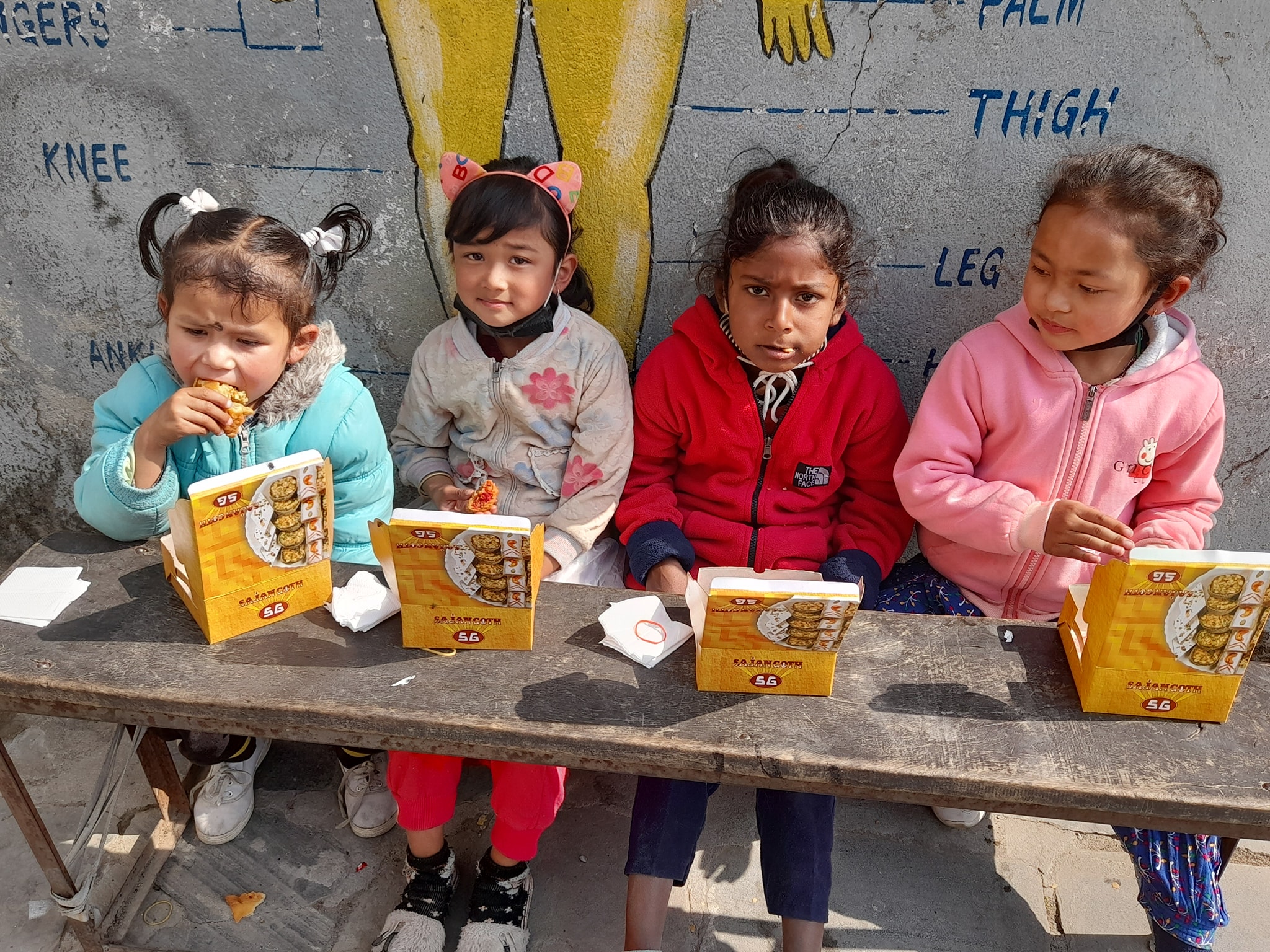 Children eating from food boxes under the Food for Naanis program headed by Jimi Prem Karthak.
Children eating from food boxes under the Food for Naanis program headed by Jimi Prem Karthak.
“This approach works because there are many people who want to help but don’t have the time to do so on their own. Nor do they know who to trust with their money. If they see there are people who are doing things in an organized way, it’s a win-win situation for all of us,” he says.
So, in that way, Food for Naanis is actually a medium to connect those who want to help with those who seek it. The program has a record of feeding 2,300 children in around two dozen orphanages in a single day.
However, transparency and accountability are often serious issues when you start taking donations, even if they come from friends and relatives. Rana made multiple appeals through social media as she sought help to provide nutritious food to pregnant women, lactating mothers and newborn babies.
To assure those who sent her money through various online payment portals, she took to posting photos of the supplies as well as the deliveries. She also posted photos of hospital bills when she used the funds to treat Covid-19 patients who were unable to afford healthcare.
Do it anyway
Karthak says transparency is sometimes a struggle because orphanages and schools’ authorities don’t always want him to take photos. It’s often a hassle to explain that he just wants to show donors that their money has reached the intended beneficiary.
It’s this complexity in an otherwise noble undertaking that makes Rimal steer clear of donations, though his circle of friends has helped him time and again. He would rather people give what they can to those in need themselves. You could, he says, start by giving a homeless person a packet of biscuits. It could be as basic as that.
“What’s important is that we change our mindset that a little won’t go a long way,” he says, urging you to imagine what, say, 500 rupees set aside from your salary every month could eventually amount to and how that could help someone who doesn’t have the same privileges in life as you.
“And think what could happen if every person in your community started doing this,” he says.
Maharjan agrees that, if you aren’t happy with how things are, you have to start doing what you can instead of always placing the responsibility on someone else’s shoulders.
“The thing about taking up social causes is that besides being an immensely gratifying experience, it’s addictive as well. Once you start and get the feel of it, you cannot stop,” he concludes.
Maids in Kathmandu: Undervalued, underpaid, undermined
A 55-year-old domestic worker was slapped because she forgot to close the main gate. She still works at the same place because ‘these things happen’.
A 33-year-old house help was fined Rs 500 because she broke a flower vase. Every other month, she says she gets less than the Rs 3,500 she was initially promised as she ‘always makes mistakes’.
A 32-year-old mother of two sons, who works from 7 am to 8 pm in various households, had to travel to her village for five days. All of her employers told her she wouldn’t be paid for those days. At every place, she had worked for over six months, without a single day off.
Maids in Kathmandu don’t have it easy. Working hours aren’t fixed. They aren’t paid decent salaries. They don’t get holidays, except for a day or two during Dashain. They can’t choose what they will or won’t do. And, worse, they are often abused—verbally and/or physically.
And yet, they continue to work under dire conditions because their families depend on their earnings, however meager. What they make helps them pay rent, buy food, or send their children to school.
“No one has hit me but I have friends who have been slapped and beaten with brooms for breaking kitchen items or daring to argue when being scolded,” says Kabita Tamang, 37, who has been working at different homes in Kathmandu for a decade now. Her first salary as a house help fetched her Rs 700 a month.
Tamang says at the first house she worked in, she would get scolded for little things like if they ran out of detergent or the dishes clanked while being put away. The comments would be scathing and derogatory. This, she adds, is normal in most of the places she has worked at. Nasty comments from employers are par for course.
The problems stem from our work not being respected, says Tamang. Some of her friends, she adds, work long hours for very less (as low as Rs 3,000 a month for two hours a day) as they themselves don’t consider what they do important. They hesitate to ask for a raise or to express their dissatisfaction over what they are told to do (like clean the toilets, for instance) fearing they will be replaced.
In Kathmandu, families, young couples, and even single working professionals largely depend on maids. The fact is everybody needs a house help. Without one, it’s like you are missing a limb. But housework is considered a menial task and those who do it are placed in the lowest rung of the social hierarchy.
Master-and-servant
This can change only if there is a system in place that ensures their rights, says Jashmin Jimee, associate at Hamri Bahini, a green social enterprise that aims to create respectable jobs for disadvantaged women.
Since 2013 Hamri Bahini has been placing women in various households for different purposes like cleaning, cooking, and babysitting. However, they have fixed hourly rates as well as the provision for weekly and yearly holidays. Unlike many maids in Kathmandu, the women they find jobs for don’t have to work erratic hours and get a day off at the end of the week.
“We also make sure the employers are ready to give their maids an annual 10 percent raise,” says Jimee.
Tamang says she was paid Rs 3,000 a month at one of the many homes she worked at. She worked for four years without a raise, till she eventually decided to quit and take up a 10 to 5 babysitting job for Rs 7,500 a month.
At City Maids Services Pvt. Ltd, the founder, Kishori Raut, says he sometimes get the sense that some people who call to inquire about the company’s services just want cheap labor.
“Most people seem to have a master-and-servant approach to this when in actuality it should be a symbiotic relationship, where both parties benefit,” says Raut.
Despite the relationship between maids and employers being one of interdependence, maids often end up as the disadvantaged party with no say whatsoever about the kind of work they do, the hours, or their pay.
Moreover, the system of hiring, even today, is mostly done informally, by word of mouth. Salary is determined randomly, based on what the employers are willing to pay or what they consider ‘enough’.
Little expectations
Shobha Budhathoki, 32, has been working as a domestic help in Kathmandu for seven years. She feels even small, basic things—like talking to them properly and not scolding them, a Rs 500 annual raise, or a day off every month if not every week—would help domestic workers feel secure and valued in their jobs.
“I don’t think we are asking for much. But the sad fact is we get so little in return for our labor. It’s hurtful but there is nothing we can do about it,” she says. Budhathoki adds that oftentimes, while being hired, they are told they need to do certain chores for a certain amount. But as days go by, the workload increases, one at a time, while the renumeration remains the same.
Prakash Basnet, founder of Help2Shine, a service that connects domestic helpers to households, says 90 percent of the 4,000 maids registered at the company have had similar, or worse, experience. Basnet says the company’s primary aim is to make sure women looking to work as domestic helpers find safe spaces where their work is valued.
“It wouldn’t be a stretch to say domestic helpers basically run the homes they work in. But they aren’t given that recognition. Rather, there is an underlying bias that makes people look down on them,” says Basnet.
This, Basnet believes, reinforces class discrimination and traps maids in a complex web of poverty from where there is no breaking free, no matter how hard they try.
“Many women have asked us not to reveal they are domestic workers. There is no dignity in the work, even though what they do is so essential to keeping a home running smoothly,” he adds.
Missing data, forgotten workers
According to Nepal’s labor force survey 2017/18, there are over three million women in the labor market. A report titled ‘Domestic Workers, Risk and Social Protection in Nepal’—by Women in Informal Employment: Globalizing and Organizing, a global research-policy network—estimates that there are 250,000 domestic workers in Nepal.
Data on them is mostly missing as domestic workers aren’t recognized as an occupational group by the Central Bureau of Statistics. The Labor Act of 2017 specifies that the government can set a separate minimum wage for domestic workers but nothing has been done so far. Domestic workers, though an intrinsic part of our society, have completely skipped the government’s radar.
Raut and Basnet both say it’s difficult to ensure domestic workers are treated and paid well as they fall under the informal sector and there are no set rules and regulations governing their employment.
Hiring of domestic workers though companies like Hamri Bahini, City Maid Services, Help2Shine and similar services can help create a better work environment for them. These companies provide workers a platform where they can lodge their complaints and which can campaign on their behalf.
A 28-year-old domestic help in Lalitpur who found work through Help2Shine says she feels secure because of the company’s backing. Being recruited through a company, she says, keeps her employers honest and gives her the confidence that her problems, should any arise, will be addressed.
However, even if domestic workers don’t go through human resource companies and find jobs on their own, within their communities, there needs to be a way to guarantee their rights.
“To change things, it’s going to take strong policies from the government’s side and more empathy from employers,” says Basnet, adding those who can afford to pay a maid can definitely afford to pay them a little better.
As Budhathoki puts it, “A 1,000 rupees might not be a big amount for those who employ us, but for us it means assured snacks at school for our children.”
Waste management in Kathmandu: Where does your garbage go?
Every day, 1,200 tons of waste collected from Kathmandu, Lalitpur, Bhaktapur, Kakani, and Banepa is dumped at the Sisdol landfill site in Kakani rural municipality, Nuwakot, according to the Solid Waste Management Association of Nepal (SWMAN). Sisdol landfill was supposed to be a temporary dumping site, meant to be used for three years. It’s been 13 years now.
In the past two years, the government has sped up landfill construction work at Banchare Danda, also in Nuwakot, and it’s expected to be complete by the (Nepali) year’s end. But without a scientific approach to waste management, experts say, Banchare Danda is fated to become the next Sisdol.
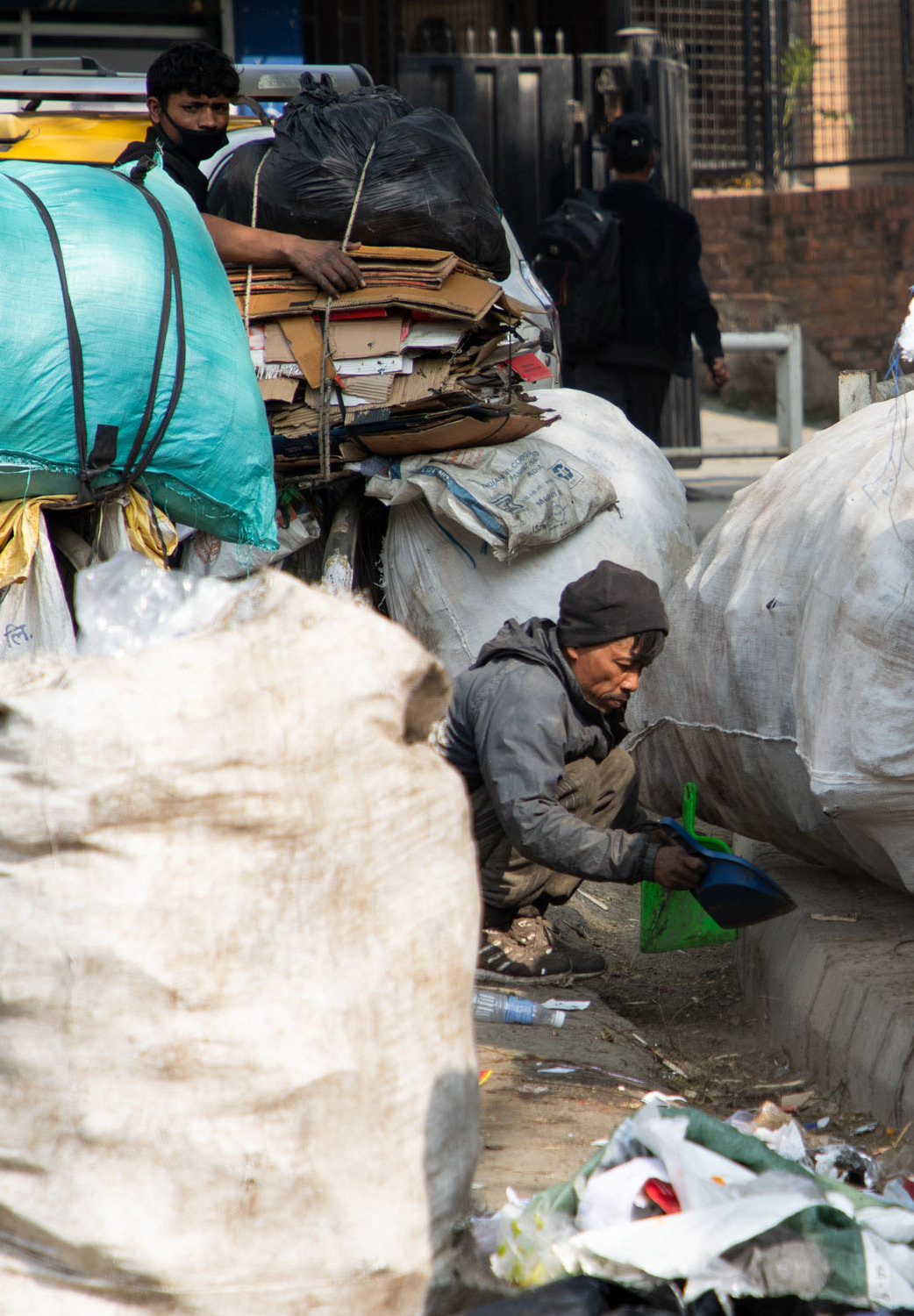
Dhurba Acharya, chairperson, SWMAN, says we need to learn from developed countries and their approaches to trash if we are to tackle our seemingly insurmountable waste management problem.
Currently, of the 1,200 tons of garbage collected daily, 65 percent is organic waste, and 15-20 percent is recyclable.
“This leaves you with very little that should actually be going to the landfill,” says Acharya. But without a proper system for waste segregation, much of the trash collected ends up in the landfill.
In recent times, a lot of emphasis has been given to recycling, upcycling, and reusing. Many people and corporate households seem to realize that the onus lies on each of us, and they are quite intent on doing their bit to reduce the amount of trash they generate. There are also many companies, organizations and social enterprises working to reduce the amount of trash that goes to the landfill.
For instance, there’s Doko Recyclers that helps you segregate your waste at its source. Khaalisisi is working towards building Nepal into one of the world’s Top 20 Recycling Nations by 2030. Upcycle Nepal Pvt. Ltd. tries to ensure all unused fabric are put to good use and don’t end up at Sisdol. Sukhawati Store Foundation promotes thrifting culture in Nepal, while Eco Saathi Nepal offers sustainable options for many daily use items that would otherwise ultimately end up in the landfill. Plus, there are many more such establishments doing similar work.
Sourced wrong
And yet, nothing has been enough to stop Sisdol from overflowing. Where are we going wrong? And what’s it going to take?
The only solution appears to lie in proper segregation of waste at its source: separating garbage into recyclable, non-recyclable, and organic bits, and disposing them off accordingly.
However, Kiran Shrestha at Action Waste Pvt. Ltd., a waste management company in Kathmandu, says segregation takes time and effort and thus most people don’t seem inclined to do it—much simpler to just dump everything in a single bin.
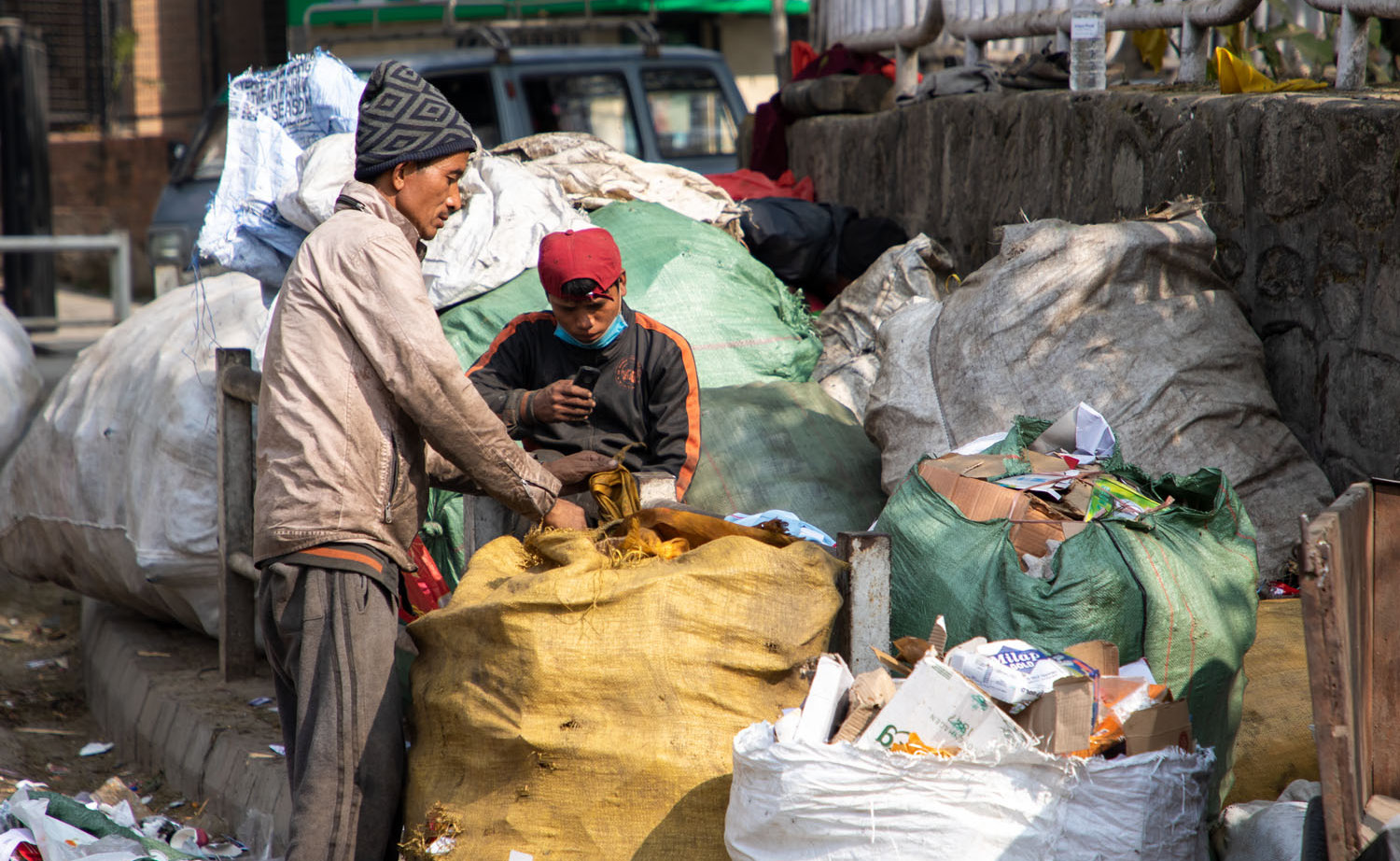
“In the areas we collect waste materials, less than two percent households segregate their trash,” he says.
An obvious but often-forgotten fact is that someone has to manually sort through our waste when we don’t: handling our waste are around 4,000 laborers from 75 private companies and municipalities. Waste-sorters often accidentally cut their hands with broken glass pieces we throw in our trash. After years in the job many of them go on to develop long-term health complications.
Laxmi Prasad Ghimire, spokesperson, Nepsemyak, a company working in the field of community-based solid waste management, believes all of us could help by composting organic waste at home. This, he says, will considerably reduce the amount of trash we collectively generate.
“I understand that a lot of people live in apartments and single rooms, but composting is possible in small spaces too. If you learn how to compost, there’s really nothing to it. Then the second step which is separating your waste into recyclable and non-recyclable bits becomes easier,” he says.
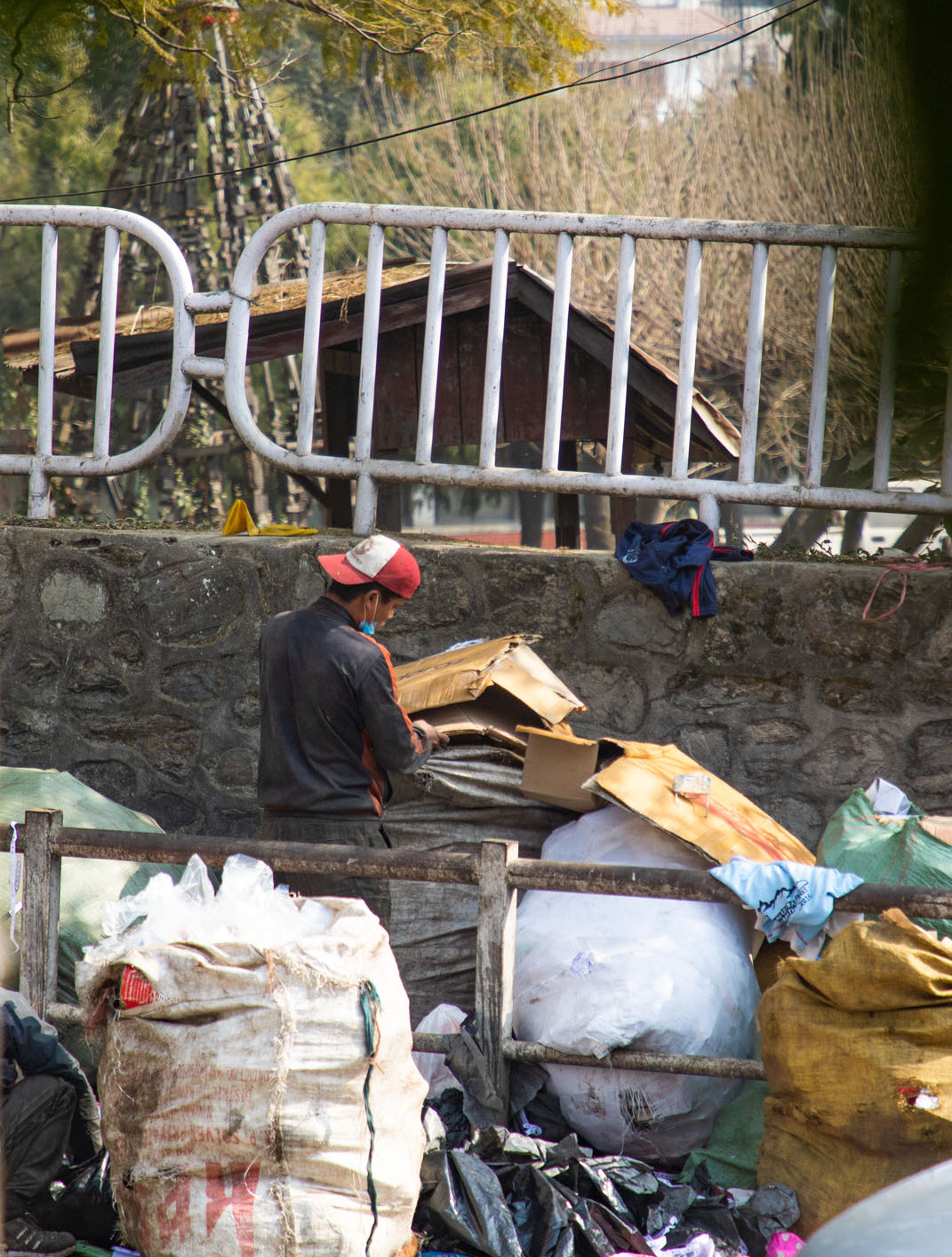
The problem, Shrestha adds, is not that people don’t know about composting and recycling but that without clear states policies and laws and their strict implementation, they simply don’t bother.
Aayushi KC, founder of Khaalisisi, says a single person or household or even a community segregating its waste isn’t enough. It can’t create the desired impact and reverse the environmental damage we are causing, bit by bit, day by day.
“I know it sounds cynical but this is perhaps the only area where a little bit won’t go a long way,” she says. What we need instead, KC adds, is a complete package with lifestyle change on the part of people and society, and policies and investment from the government’s side.
KC says people need to be given incentives to segregate and recycle. This is one reason why at Khaalisisi they insist people take money for their recyclables and not just give them away for free. The fact that you can make an income, however meager, from things you are throwing away could act as a motivator of sorts.
Absent awareness
There is also a huge problem in the way collection is currently carried out, making segregation pretty pointless, say those working in the sector. Even if segregation happens at the source—meaning households, offices, and the like—waste materials are dumped together in the same vehicle when they are picked up.
“It can be extremely discouraging to those who take the trouble of separating their wastes,” says KC.
Shrestha, of Action Waste Pvt. Ltd., cites lack of public awareness as the reason for all sorts of waste being collected together. He recalls a time when Action Waste collected dry waste and wet waste on different days. But people would invariably throw mixed waste on both days.
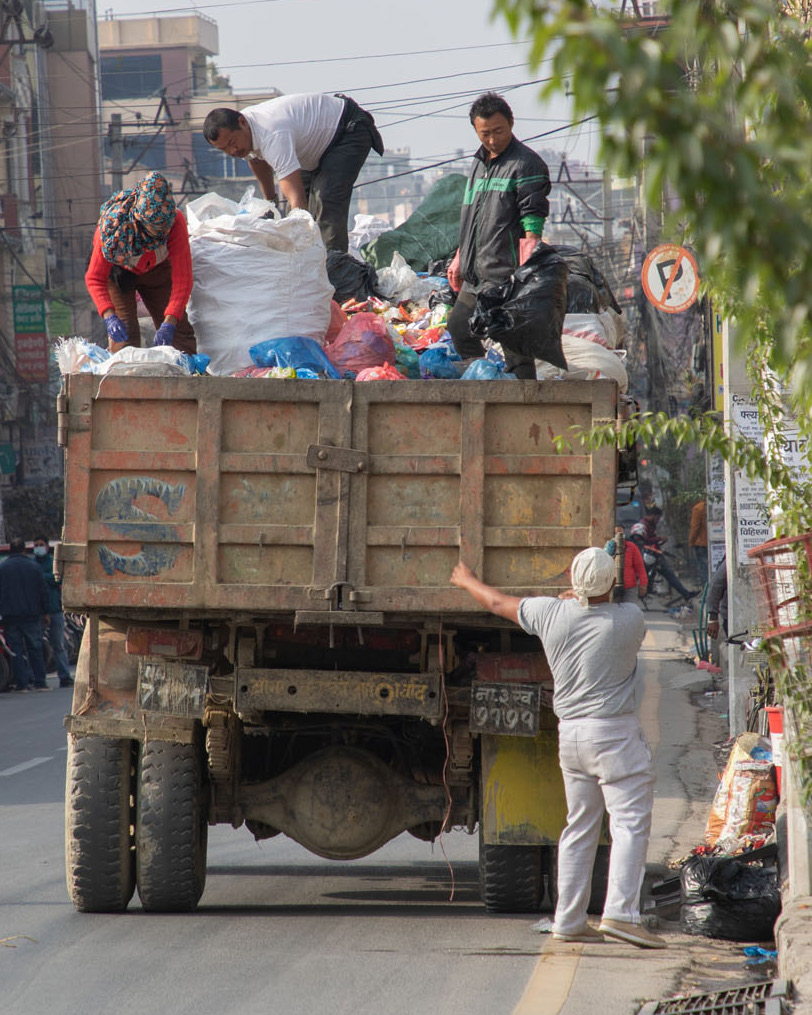
Ghimire agrees that this method, if strictly practiced by each and every household, could bring us a step closer to creating a proper waste management system. Unfortunately, the behavioral changes needed for that will take time. Meanwhile, a comprehensive awareness of proper waste management has become essential.
The situation isn’t all bleak though. Many startups and companies have taken it upon themselves to help people follow the three Rs—Reduce, Reuse, and Recycle—to cut down the amount of waste that reaches the landfill.
Rajan Chakradhar, cofounder of Upcycle Nepal Pvt. Ltd., mentions that on average they get 300 to 400 kilos of clothes and scrap fabric every month. They repurpose these to make bags, scrunchies, and other accessories besides donating clothes that are in wearable condition to those in need.
“If people have clothes they are about to toss out, they can give them to us and we’ll keep them from ending up at Sisdol,” says Chakradhar.
Mani Karki, founder and CEO of Eco Saathi Nepal, thinks it’s imperative to shift the focus on sustainable living as it’s possible to greatly reduce waste by replacing single-use items with greener alternatives.
From compostable bamboo toothbrushes, hairbrushes and cutleries to metal straws, reusable cotton makeup removal pads and menstrual cups, Eco Saathi Nepal offers many things one would need to make the switch to a sustainable lifestyle.
Similarly, by promoting thrifting or secondhand shopping, Sukhawati Store Foundation has, in four years, prevented 30,530.73 kilos of goods from being discarded.
“Thrifting is important in reducing waste and though it’s a relatively new concept in Nepal, people seem to be more aware about it these days,” says Samita Rana Magar, coordinator at Sukhawati Store Foundation.
The foundation has various drop points—in Nakhipot, Banasthali, Bhaisepati, and Durbar Marg—where you can leave clothes, shoes, bags, accessories, electronics, and other items you would like to give away. Alternatively, you can also request them for a pick-up service.
Collective effort
Experts’ undivided opinion was that, given the breakneck speed of urbanization and our inadequate waste management infrastructure, companies like these working to minimize waste can slow the pace of waste reaching the landfill. But their efforts will be futile without adequate public support.
Stuti Sharma, communications and advocacy coordinator at Doko Recyclers, says people aren’t very enthused about proper waste management. There’s hope though as the idea of recycling and reducing are slowly entering people’s minds because of all the conversation surrounding sustainability and environmental preservation, especially on social media.
“There are so many private industries and organizations working together to manage waste properly that it’s bound to bring about change sooner or later. But people also need to understand that not everything can be recycled and try to create less waste,” she says. And it’s not that hard, she adds, if you are a little conscious about what you are using on a daily basis.
All set for 2021: Learning from the pandemic-hit 2020
This time last year, we were busy drawing up a resolutions list—things we wanted to do, goals we wanted to accomplish, places we wanted to go, and changes we would like to make in our lives—determined to make 2020 better than 2019 and not let the latter bleed into the former. As desperate as we are to cut ties with 2020, pretend like it never happened, many of us have allowed it to set the theme for 2021. The lessons it has taught us are crucial.
Nayana Amatya Rajbhandari, chief operating officer at Knowledge Holding International Pvt. Ltd., says her action word for 2021 is ‘try’.
She will ‘try’ to be more flexible—with her plans, how she deals with family, and her daily work schedule. She will ‘try’ to cook more of what her family likes but also ‘try’ to spend less time doing so. She will ‘try’ to be more in the present. She will ‘try’ to be less stressed.
_20210101140348.jpg)
The past year has made her realize that while she can juggle multiple things simultaneously—home, work, children—there’s no way she can stay on top of her responsibilities all the time. The best she can do is cut herself (and others) some slack and try to be a better version of herself.
2020 seems to have brought about a drastic shift in perspective. It has changed how we view ourselves, our lives, and the world around us. For many, resolutions this year come from lessons learnt in the past 10 months or so. And for many of these are inward-focused rather than goal or ambition driven.
There’s always a bright side
For Sunaina Saraf, co-owner at Innovations, an interior designer firm, 2020 was a year of incredible inner strength and positive energy. Most people, she says, might remember 2020 for the losses they have incurred but she’d like to think of it as a year that showed her many strengths.
“The past year has taught me to be kinder to people I work with and show more empathy,” she says adding that her one-to-one dealings with people, compared to group meetings earlier, have changed interpersonal dynamics.
Saraf has also started seeing life a little differently. Today, she strongly believes something good can come out of every situation and she is learning to harness this powerful energy. She isn’t denying that there will definitely be fear and uncertainty in 2021 but she is ready to handle whatever new challenges the year might bring.
Ankeet Rajbhandari, who works at a life insurance company, says despite all the negativity of 2020, he too would like to focus on the positive aspects. In hindsight, the year taught him the importance of being disciplined, focusing only on what’s necessary thus letting go of little things, and the value that’s in being surrounded by family.
_20210101140342.jpg)
Don’t dwell on what you can’t change
Some people APEX contacted for this story were hesitant to talk about their 2020 experience. They felt their views and stories didn’t matter when the world was reeling under such catastrophe—with many people losing their loved ones, jobs, and simply struggling to survive. Having had the luxury to stay at home and not having to worry whether the lockdown would take away their livelihoods, they felt their issues were trivial and thus not worthy of being talked about.
But life has indeed been difficult, for all of us. In our own ways, we have suffered and felt lost as we grappled with the circumstances. Mental health issues have reared their ugly heads. Most of us have had to contemplate and rethink our priorities and goals as well.
Smriti Nepal, who lives in Sydney, Australia and has a doctoral degree, was supposed to get married in 2020. She was to spend three months hosting her beloved niece during her holidays. And her family were to be together to ring in the new year. None of these things happened. Each cancelled plan, she says, was accompanied by crushing disappointment.
“My biggest learning has been to not dwell on what I can’t change. Of course, I always knew this but 2020 gave me the opportunity to practice it. This mantra also keeps anxiety at bay,” she says.
Sneha Koirala, founder of the lifestyle brand Studio Sarcastic, says 2020 put life on hold but she also got the chance to reorganize her plans. She could finally do things she had wanted to for a long time but kept putting off for one reason or another. Turns out, all she needed was some time to gather her thoughts and courage.

Embrace change and live in the moment
What’s amazing is that despite all that 2020 has thrown our way, quite a few have managed to keep their faces to the sunshine. As trying as the year was, 2020 has taught us some invaluable lessons.
One of the biggest has been staying focused in the present and learning to take things one day at a time—which, many confessed, they didn’t do prior to the pandemic in their haste to accomplish one task or goal after another.
Pavitra Rana, program officer, FAITH, a non-profit organization working for socially marginalized and vulnerable populations, says Covid-19 might have put a halt to many of her plans but she has come to the realization that sometimes it’s okay to sit back and see how things unfold in your life rather than rushing into things just so you do them at the ‘right’ time (or as per the status quo). Keeping that in mind, she intends to let life take its course and be flexible in her approach to living in 2021.
“This year, I’d like to not be attached to anything—be it plans, dreams, or other materialistic pursuits,” she says. If there is one thing 2020 has made clear, she says, it’s that things will not always go according to your plan and you need to be okay with that.
Rajbhandari also feels 2020 has taught us to embrace change and learn to adapt to it and do so swiftly. This mentality, he believes, will help him tackle challenges more easily and efficiently this year.
One of our intrinsic flaws has been our inability to go with the flow. We plan and we expect everything to fall into place accordingly. It rarely does. And it’s never been more apparent than in 2020.
From now on, Rupam Shrestha, who works at Sipradi Trading, intends to have long term projections as well as short term goals. This, he believes, will help you to maintain focus and direction when things aren’t going as you expected them to.
Isha Karki, assistant brand manager at Rohto-Mentholatum Nepal, swears she will always have a plan B—because you never know when you might need it.

Connections and kindness
For Alok Thapa, senior radio program producer and presenter at Hits FM 91.2, the year 2020 was of prioritizing what mattered. Thapa is glad he got to spend quality time with his parents, listening to their stories of ‘old’ Kathmandu. He also connected with his neighbors—something he wishes he had done sooner.
“I think 2021 isn’t going to be any less challenging. It will still require a lot of prioritizing and patience. But after a year like 2020, I feel nothing is off limits,” says Thapa.

2020 has forced us to slow down. And in doing so, we have had the opportunity to realign our lifestyles with our values. So, taking care of one’s mental wellbeing, learning to live with less, and finding balance between home and work seemed to be the top three resolutions for the new year. The focus is more on ‘being’ than ‘having’.
A US-based Nepali medical doctor, who saw Covid-19 claim many lives, says that 2020 has made it evident that life can change in the blink of an eye and that sometimes there is nothing you can do about it. Faced with the fragility of life, you are bound to reconsider all that you believe to be true and let go of grudges. Be a little kinder than necessary, if you may, she says.
According to Nepal, the Sydney-resident who works in drug prevention/mental health research, 2020 has shed light on the importance of connection and resilience. In 2021, she hopes to be a better daughter, partner, sister, and friend. This, she says, comes from the fact that she couldn’t see many of her family and friends in the past year.
Prita Malla, mother, wife, and business analyst at Spire Energy, a public utility holding company based in Missouri, US, wants to be more mindful of her actions and live each day to the fullest while making self-care her number one priority.
“I think we have to accept that this coronavirus is here to stay and tweak our perspective of what’s ‘normal’. We must also let go of what’s not in our control and focus on things we can change. That’s the best way to move into the new year,” she concludes.
Mismatched: A cute, fun story
Don’t listen to your friends. Mine told me to watch ‘Mismatched’ on Netflix. I did and now, the story is stuck in my head and I can’t get it out. The second season of the series hasn’t been announced yet. Though the producers are likely to do so in the near future, thoughts like “What if they don’t?” and “How long do I have to wait?” are slowly sucking the air out of my universe. The six-episode first season ended on a cliffhanger.
Released on Netflix in November 2020, Mismatched, written by Gazal Dhaliwal, is based on Shandhya Menon’s 2017 young adult novel “When Dimple Met Rishi”. In the rom-com, a girl and a boy are set up to meet (and eventually get married) by their families. The girl, Dimple Ahuja, doesn’t want to “settle down”. She is intent on building her career. However, when she meets Rishi Singh Shekhawat, at a three-month coding program she is enrolled in, the two become friends and eventually fall in love.
The premise is simple. It’s every other rom-com you have ever watched: Boy meets girl, they fall in love, but then there’s a conflict to spice things up. But what makes Mismatched different is definitely the cast. I liked the actors and their interpretations of their characters. They are all believable and charming in their roles—even the annoying ones.
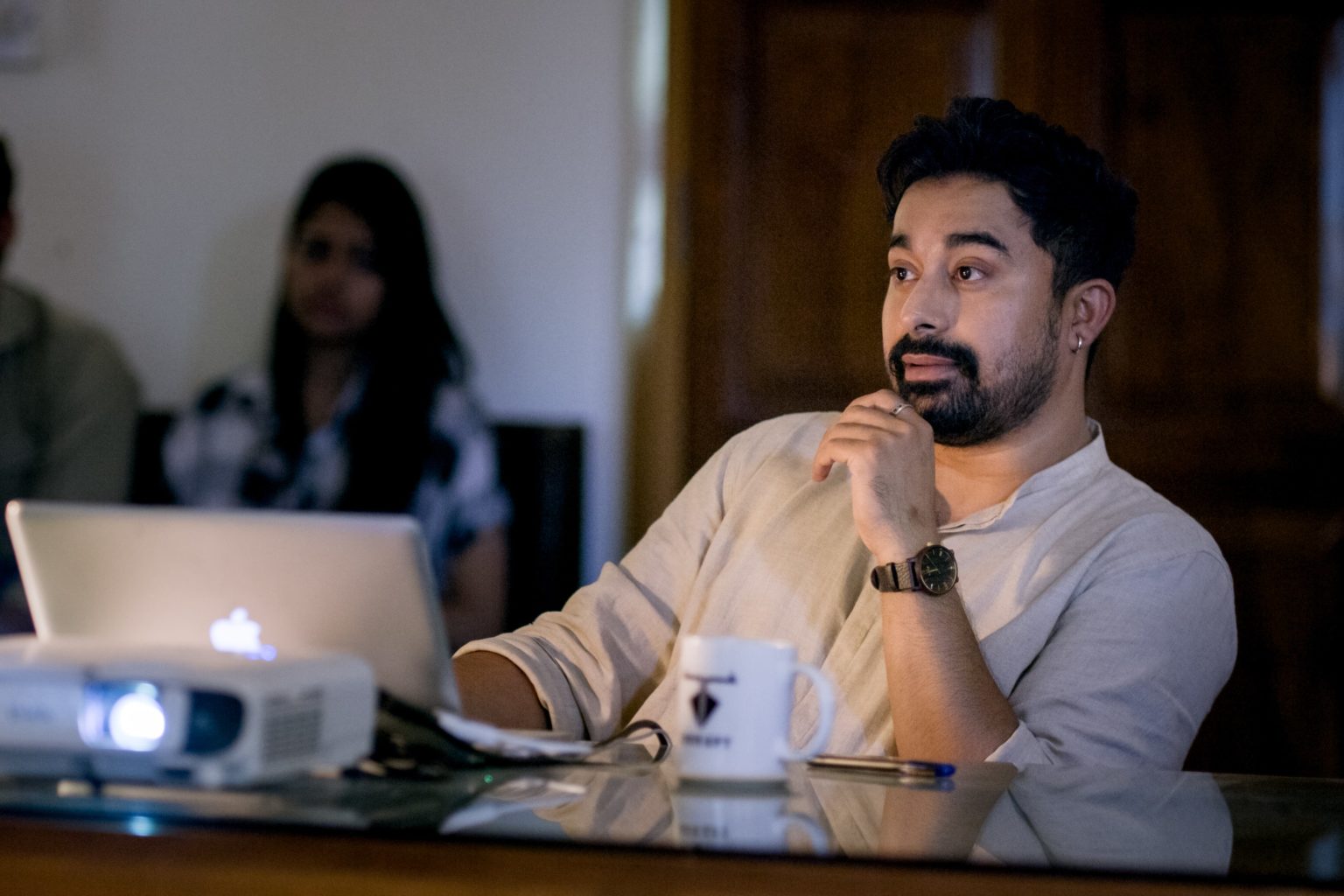
Dimple, played by one of India’s most popular YouTubers, Prajakta Koli (you might have heard of mostlysane) is fascinating and frustrating at the same time. You see yourself or your friends in her, and then you don’t. You love her, and then you hate her. She is every girl.
It's hard not to be smitten by Rishi—the dashing Nepali actor Rohit Saraf who has been a part of movies like ‘Dear Zindagi’, ‘Hichki’, and ‘The Sky Is Pink’. He is gentle, soft-spoken and kind. He is the friend you want, and the boyfriend you wish you had.
In the role of Professor Sid is actor, MTV VJ, and host of the popular reality show Roadies, Rannvijay Singh. He shines in his role of a sarcastic, no-nonsense teacher who believes in being strict to push his students to be the best versions of themselves. Even if that means he is misunderstood and feared.
And, remember Vidya Malvade who was the captain of the Indian hockey team in the Shahrukh Khan-starrer ‘Chak De India’? In Mismatched, she is a 41-year-old widow trying to start a new life and is back at school. As Zeenat Karim, she is adorable and you wish she had been given more screen space.
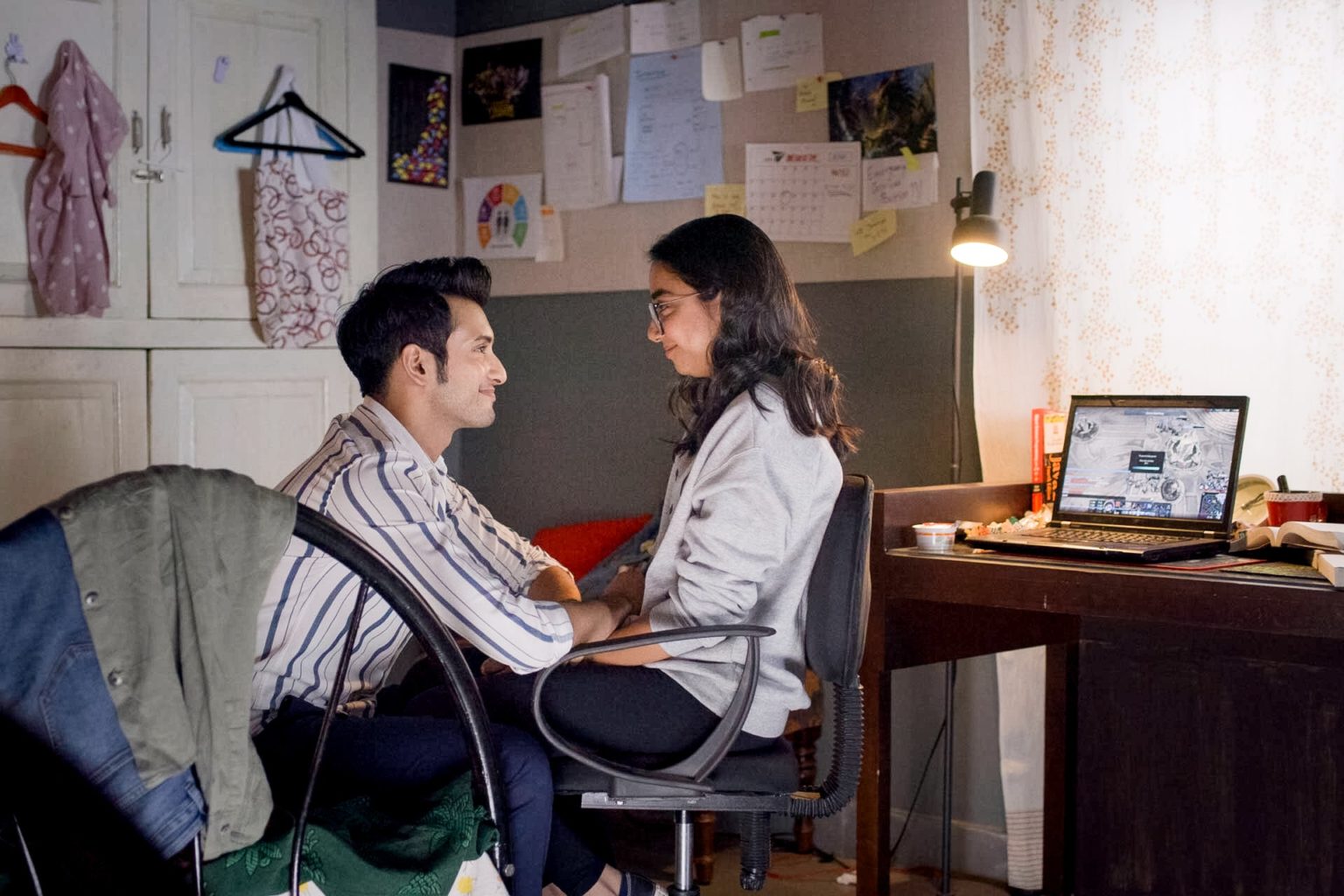
Mismatched touches on a few critical issues but doesn’t do any of them justice, choosing instead to focus on Dimple and Rishi and their love story. In doing so, it misses out on telling stories—of a closeted lesbian, and a guy suffering from alopecia, for instance—that could have started important conversations. There is a lot of potential for that, with actors and characters who could have pulled it off with ease. There are also a few glitches and oops moments in the storyline—wrinkles that neither the writer nor the editor thought of ironing out.
However, Mismatched is as entertaining as entertainment can get. With short episodes, you could watch the entire first season in a single afternoon. But be warned, you will spend the rest of the weekend wishing there were more.
Rating: 3/5
Genre: Rom-com
Actors: Prajakta Koli, Rohit Saraf, Rannvijay Singh, Vidya Malvade, Aditi Govitrikar
Director: Akarsh Khurana & Nipun Dharmadhikari
Run time: Six episodes of 30 minutes each














